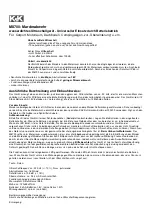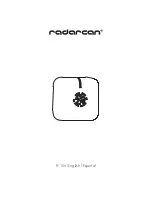
9
Training/Instructions
Personal protective equipment against falls from a height must only be used by persons, who have been instructed according to the valid
national working conditions act. We are pleased to inform you about training for INSTRUCTIONS or COMPETENT PERSONS.
3 Period of use
The operating life of this safety product essentially depends on the type and frequency of use as well as on the conditions of use, diligent
care and storage and therefore can not generally be defined.
Products made of chemical fibres (e.g.: polyamid, polyester, aramid) are
subject to certain ageing even if they are not used, especially depending on the intensity of ultraviolet rays as well as on the climatic
environmental influences.
Maximum longevity of 12 years
The maximum longevity of A.HABERKORN products in synthetic and textile material is 12 years from the date of production under optimal
storage conditions and without being used.
Maximum operating life of 10 years
The maximum operating life with occasional, proper use without visible wear and tear under optimal storage conditions is 10 years from
the date of first use.
Storage period of 2 years
The storage period before first use and without reducing the maximum operating life is 2 years from the date of production.
Provided that all instructions on safe handling and storage are observed, the following,
non-binding indications on the lifespan can
be recommended
:
•
Intensive, daily use
- less than 1 year
•
Regular use throughout the year
- 1 year to 2 years
•
Regular seasonal use
- 2 to 3 years
•
Occasional use (once a month)
- 3 to 4 years
•
Sporadic use
- 5 to
max. 7 years
Metal fittings such as buckles, karabiners, etc.:
The life of metal fittings is generally unlimited; however a periodic inspection of metal fittings must be carried out regarding damage,
distortion and wear as well as functioning.
When different materials are used in one product, the period of use is subject to the most sensitive materials.
Extreme conditions of use can cause the elimination of a product after only using once (type and intensity of use, field of application,
aggressive environment, sharp edges, extreme temperatures, chemical substances etc.).
A PFPE must definitely be discarded:
•
in case of damage to supporting parts, which are essential for safety, such as webbings and seams (tears, cuts or other)
•
in case of damage to plastic and/or metal fittings
•
in case of strain by a fall or heavy load
•
after the application period has elapsed
•
if a product does not seem safe or reliable anymore
•
if the product is outdated and does not comply with the technical standards anymore (modification of legal regulations, norms
and technical rules, incompatibility with other equipment etc.)
•
if the history of use is unknown or incomplete (test manual)
•
if the identification of the product does not exist or if it is illegible or missing (even partly)
•
if the instructions for use/test manual of the product are missing (because product history can not be tracked!)
•
See also item: 2) Regulations for the owner of the equipment
If the visual inspection carried out by the user, holder of the equipment or the competent person results in complaint or if the PPE has
elapsed, it has to be discarded. The elimination has to be made in such a way that reuse in action can absolutely be excluded (e.g. by
cutting and disposing of belts, fittings etc.). In case of frequent use, intensive wear or extreme environmental influences, the allowed
period of use becomes shorter. The decision on the operational capability of the device is up to the responsible COMPETENT PERSON
within the prescribed periodic inspection.
4 Liability (complementing point Caution)
Neither the A.HABERKORN & Co GmbH nor its sales partners assume any liability for accidents in relation to the present
product and consequential personal and/or material damage, especially in cases of misuse and/or incorrect use. In all cases
the users are responsible for risks taken.
5 General notes for use
In addition to all required standards, the sharp edge rope
„EDGER“ was tested on edge resistance according to Appendix A of EN
354:2008.
This is shown by the edge symbol, which has the following meaning:
The lanyard was successfully tested for horizontal use with a fall over a burr-free 90° steel edge with a radius of
0.5 mm (PPE-Directive 89/686/EEC
– CNB/P11.060, edge-type A). Consequently the lanyard can be use in
combination with a fall absorber in case of similar edges, such as rolled steel profiles or wooden beams. In
addition to the edge defined in prEN354:2008 Appendix A, the sharp edge rope
„EDGER“ was also tested over a
burr-free steel edge of cold drawn steel, 90°, radius approximately 0.0 mm. A test over a sharp-edged concrete slat
has also been carried out.
a)
Based on the PPE-Directive 89/686/EEC
– CNB/P/11.054, the product “EDGER” has successfully passed the fall over a sharp
edge (type B).
Definition of sharp edge (type B) (PPE-Directive 89/686/EEC
– CNB/P/11.054):
A steel edge without radius fabricated out of a
square steel bar according to EN 10278:1999-12 (Material: C 45+C or E335 GC (ST60) according to EN 10025). Therefore the
equipment may be used with similar edges, such as trapezoidal sheet metal.
The points items should be well-considered, if the equipment is going to be used in horizontal or diagonal configuration including the
risk of a fall from a height:










































